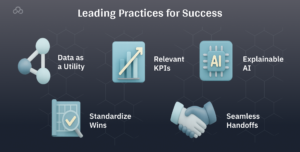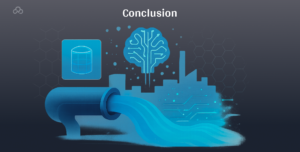The amount of water used in an industrial setting is critical for its use in the production of products, longevity of equipment, and also potential regulatory issues. Due to the necessity for a facility to be able to treat massive quantities of process water, it is important to protect equipment, ensure compliance with regulations, as well as minimize the amount of damage done to the environment.
To achieve this, it is necessary to produce consistent results that meet very specific standards while keeping costs down on both the amount of energy consumed and chemicals used.
Fortunately, today there are many new tools available to support a successful AI water management strategy, including the ability to identify and correct problems before they become serious issues using artificial intelligence (AI) based water quality monitoring systems; digital twins; and the ability to test proposed changes to a treatment system without the need to actually make those changes.
In the realm of industrial water treatment, adopting a cutting-edge water treatment system is paramount. This is where AI as a service truly shines, providing advanced analytical capabilities that transform raw data into actionable insights. These intelligent water treatment solutions are key to optimizing processes and ensuring environmental compliance.
Common Pain Points in Water Treatment Systems
1. Changes in raw and process water quality (variable influent) require frequent adjustments to treatment. Therefore, real time monitoring and the ability to adjust treatment systems as needed will be critical to ensure that treatment is both efficient and effective.
2. Mineral build-up (scaling) and biological growth (biofouling) will continue to block filters and reduce the overall effectiveness and increase the maintenance requirements of the system.
3. Stricter discharge limits, increased auditing, and continuous monitoring will create additional regulatory compliance and documentation challenges for wastewater treatment plants. Reliable data and automation will be required to meet new regulatory requirements.
4. Energy usage for aeration, pumping, and solids handling in wastewater treatment is high. By optimizing each of these areas and incorporating renewable energy sources, cost savings can occur.
5. Accurate chemical dosing, safe storage and handling of chemicals are necessary to prevent unnecessary waste and exposure to potential health and environmental hazards.
6. Integrating treatment into production schedules will become increasingly complex due to the integration of treatment into production schedules, while addressing emerging contaminants such as PFAS, pharmaceuticals and microplastics will require advanced technology solutions.
7. Important information related to treatment operations, chemical management and maintenance is typically fragmented between multiple different systems or applications. The lack of integration of this important information will make it challenging to perform an integrated analysis of the entire operation.
The evolution of water treatment technology is rapidly advancing, offering sophisticated tools for every aspect of industrial water treatment. From initial influent analysis to final discharge, a modern water treatment system leverages innovations like digital twins and advanced membrane filtration. This integrated approach ensures efficiency and sustainability.
Modern Solutions: Tools That Deliver Results
AI + IoT Monitoring: Continuous Oversight
Use good sensors to measure in real time. Feed this data into an AI for water quality monitoring. Water treatment systems quality will be monitored continuously through the AI and predictive maintenance. The AI can predict anomalies, future conditions and patterns that may occur. Surprises lessen with less surprises; operations run more smoothly; decision making is better.
Key benefits: Managing variable influent, precise dosing, early leak detection, and predicting equipment failures.
Digital Twins: Safe Optimization
Digital twins create a virtual replica of your treatment plant. By doing so you are able to evaluate scenarios and optimize processes. This provides an opportunity to evaluate changes (i.e., recycle rate, DO concentration) on the digital twin first; this way you can see how they will affect performance prior to applying those same changes to the actual treatment plant. The potential for error is greatly reduced with this approach.
Key benefits: Stable effluent, lower energy consumption, fewer over-corrections, and faster troubleshooting.
Membranes: High Purity Standards
Advanced filtration and membrane technologies handle emerging contaminants effectively. These include ultrafiltration (UF), nanofiltration (NF), and reverse osmosis (RO).
1. Ultrafiltration (UF): This removes fine solids (2 to 100 nanometers).
2. Membrane Bioreactor (MBR): This combines biological treatment with membrane separation. It provides high-quality effluent in compact systems.
3. Nanofiltration (NF) and Reverse Osmosis (RO): These address dissolved loads, hardness, and micropollutants. RO is vital for high-purity water, while NF handles divalent and multivalent ions.
Important consideration: Membranes need effective pretreatment and AI-driven management. This optimizes cleaning cycles and prevents fouling.
Chemical-Lean Polishing: Targeting Stubborn Contaminants
Chemical-free processes reduce reliance on chemical dosing. Examples include electrocoagulation (EC) and advanced oxidation processes (AOP).
1. Electrocoagulation (EC): This generates coagulants in situ. It reduces the use of bulk chemicals.
2. Advanced Oxidation Processes (AOP): These use methods like peroxide/ozone/UV. They target recalcitrant organic compounds.
Best used when: Conventional methods are not enough, or when you want to reduce on-site chemical handling.
Automation and Control Software: Streamlined Operations
The integration of automation and control software to combine treatment operations with those of a manufacturer can provide for a very consistent operation of the treatment process. The automation and control software will provide recommendations and alerts that are able to be viewed through the use of the current system used by the manufacturer (SCADA, Historians, LIMS, CMMS) as well as provide a one click roll back feature for the user to protect the users from making an error with the use of AI based water treatment system management.
Outcome: Reduced manual effort, clearer operational intent, and increased operator trust.
Energy Optimization: Consistent Savings
Optimizing and investing in the use of energy efficient equipment and optimization of the treatment processes will greatly reduce the amount of energy required to treat the wastewater. The use of smart blowers and DO control, the use of VFD driven pumps, the use of tariff aware pump scheduling, and the use of heat recovery will allow for fixed cost of treating the wastewater to become variable cost.
Furthermore, the integration of AI as a service into water treatment technology is revolutionizing how industries manage their water resources. This allows for predictive maintenance and real-time adjustments within the water treatment system, leading to significant cost savings and improved operational reliability. These comprehensive water treatment solutions are essential for navigating today’s complex regulatory landscape.
Leading Practices for Success

– Data as a Utility: Ensure calibrated analyzers, synchronized timestamps, and clean data naming.
– Relevant KPIs: Focus on metrics like kWh per m³, chemical kg per ML, delta-P across assets, non-revenue water, and MTBF.
– Explainable AI: Operators must understand AI decisions to trust them. Prioritize transparent features and clear alerts.
– Standardize Wins: Formalize successful solutions. Then, replicate them across similar operations.
– Seamless Handoffs: Ensure consistent clarity across shifts. Use identical screens, guardrails, and audit trails.
With a holistic strategy using modern water treatment technology, expert knowledge, and proactive maintenance, your industrial water treatment can become an operational advantage. This includes leveraging AI as a service for early warning systems and optimizing your entire water treatment system to deliver comprehensive water treatment solutions.
Future Trends in Industrial Water Treatment
Industrial water treatment has evolved dramatically over time as have many areas of the world. The trend toward the future of industrial water treatment continues today and is being led by new regulation, innovative technology, and a commitment to sustainability. As we can see there are some key areas that are leading the way in industrial water treatment.
1. Advanced Artificial Intelligence (AI) and Machine Learning (ML): AI will be able to predict when and how much it will cost to maintain your equipment, optimize your treatment processes autonomously, and create new designs for treatment processes.
2. Circular Economy Principles: There will be an increased emphasis on using treated effluent for non-potable uses such as irrigation or toilet flushing, reusing and recycling treated effluent, and recovering valuable resources from wastewater.
3. Improved Sensor Technologies: Sensors will be smaller, stronger, and less expensive allowing for the ability to continuously monitor contaminants in real-time and get instant information on what is happening in the treatment process.
4. Modular and Decentralized Treatment Systems: Modular and decentralized systems will become more popular because they can be deployed quickly, easily scaled up or down as needed, and relocated if needed.
5. Integration with Industry 4.0: Water treatment will be integrated with all other aspects of an industry’s operations so that water treatment can be optimized in relation to the rest of the operation.
6. Sustainability (Energy Neutrality/Cost Savings/Carbon Footprint): All new treatment plants will strive to be energy neutral and incorporate methods to reduce their carbon footprint during the design phase.
Technical FAQs
1. Can AI actually run parts of my plant?
Yes, but start with a human-in-the-loop approach. Allow models to recommend setpoints. Implement bounded automation in stable conditions. Always include audit logs and a rollback feature.
2. What is the importance of integrating AI in water treatment design?
AI enables process optimization and predictive control. It uses real-time data analysis. This minimizes chemical and energy consumption. It also ensures consistent output quality.
3. UF/MBR vs NF/RO, how do I choose?
Use UF/MBR for solids removal and biological polishing. Choose NF/RO for dissolved salts, hardness, or micropollutants. UF followed by RO is common for reuse and high-purity applications.
4. How does digital twin technology facilitate improvements in treatment system design?
By emulating plant processes, designers can evaluate conceptual changes. This happens before implementation. It reduces risk, expense, and downtime. It also maximizes data-driven decisions.
5. Will EC/AOP replace chemicals entirely?
Typically not. EC and AOP reduce reliance on certain chemicals. They also target difficult organics. Often, they are integrated alongside conventional steps and membranes.
6. What’s the fastest way to cut energy?
Prioritize aeration and pumping. Smarter DO control, VFD-driven pumps, and tariff-aware scheduling often yield the most significant immediate savings.
7. Is AI Worth It for Small Utilities?
Yes, if implemented strategically. Targeted applications like leak detection, predictive maintenance, or smarter dosing can quickly show payback. Cloud-hosted systems help manage costs.
8. How Do We Justify ROI?
Establish a baseline for a key performance indicator. Conduct a controlled pilot. Present financial data. Sustained results for a few months justify scaling the solution.
Conclusion

Industrial Water Treatment is getting progressively more complicated. The key to success will be to combine strong and resilient unit process with intelligent, plant aware solutions; Membranes to provide the highest level of purity, EC/AOP to deal with the most difficult organic contaminants, AI for early warning systems, Digital Twins for Risk Free Testing and Integrated Automation and Control Software.
With a Holistic Strategy using Modern Technologies, Expert Knowledge, Proactive Maintenance, Industrial Water Treatment can become an operational advantage. Less Issues, Longer Asset Life, Clean Heat Transfer, Fewer Emergency Call Outs, Measurable Reductions in Energy Consumption and Chemical Usage. Most importantly, this allows for control and evidence that AI based decision making are Safe, Explainable and Repeatable Across Operations.
Do you like to read more educational content? Read our blogs at Cloudastra Technologies or contact us for business enquiry at Cloudastra Contact Us.